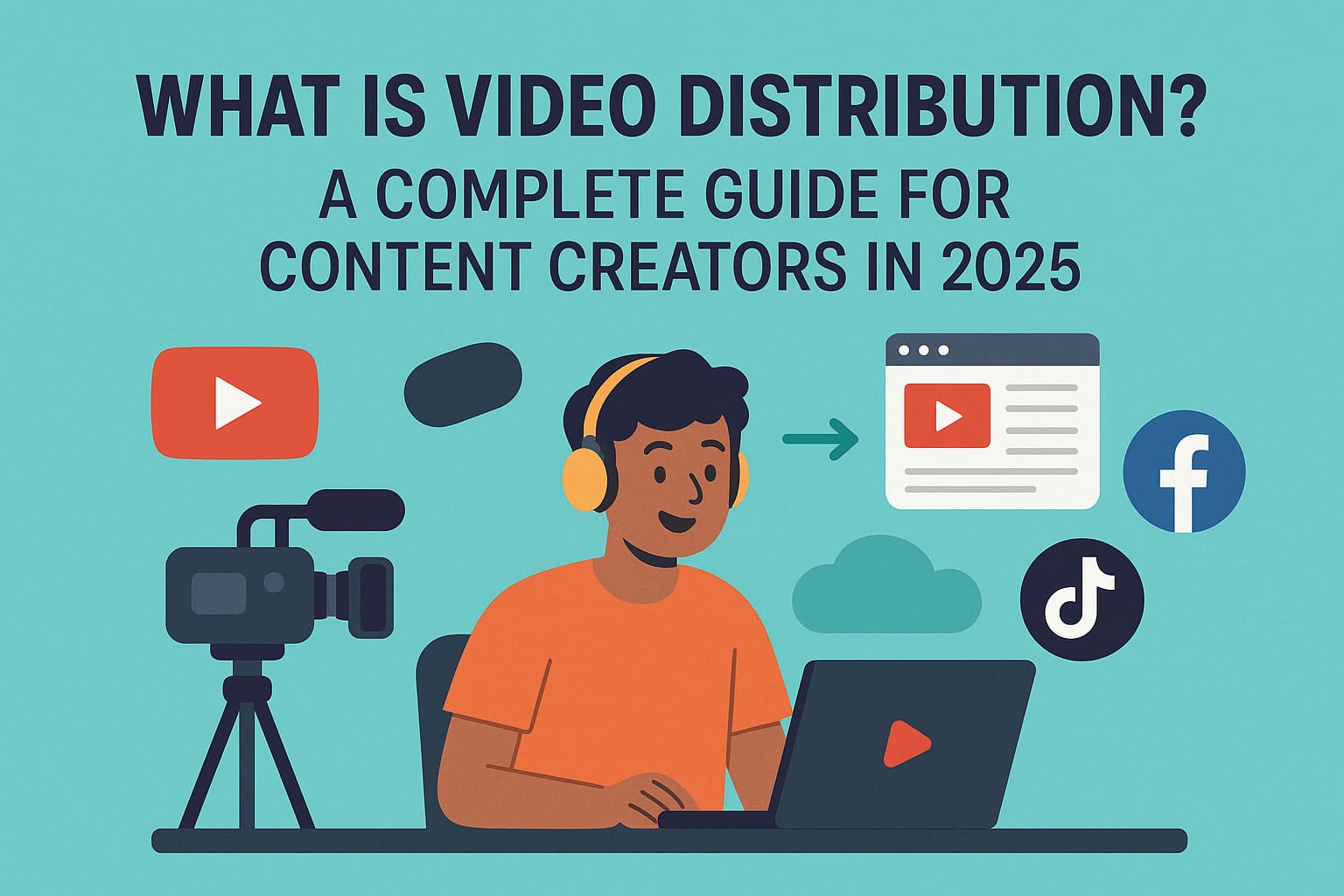Video has become the king of content in 2025. With billions of people consuming video daily across platforms like YouTube, Instagram, Facebook, TikTok, and OTT apps, the demand for high-quality video content is at its peak. But creating a great video is only half the journey—the other half is ensuring it reaches the right audience. This is where video distribution comes into play.
In this comprehensive guide, we’ll cover everything content creators need to know about video distribution in 2025, including strategies, platforms, benefits, and expert tips to help your videos gain maximum visibility and engagement.
If you’re a creator looking to scale your audience and grow globally, you’ll find this guide a valuable roadmap.
👉 Also, check out ST Digital’s professional video distribution services to take your content from local to global effortlessly.
What is Video Distribution?
Video distribution is the process of sharing your video content across multiple platforms and channels to reach the widest possible audience. It’s not just about uploading a video on YouTube; it’s about strategically placing your content on different digital platforms, OTT apps, social media channels, and even paid advertising networks to maximize its visibility and impact.
In simple terms:
Video distribution = Getting your content seen by the right people, at the right time, on the right platforms.
Why is Video Distribution Important in 2025?
The year 2025 has brought new challenges and opportunities for content creators. With the rise of short-form videos, algorithm-driven feeds, and increasing competition, distribution has become more critical than ever. Here are some reasons why:
- High Competition – Millions of videos are uploaded daily; smart distribution makes yours stand out.
- Algorithm Dependence – Platforms like TikTok, Instagram Reels, and YouTube Shorts push content based on engagement; wider distribution improves chances of being picked.
- Global Audience – Distribution helps creators go beyond local viewers and reach international fans.
- Monetization Opportunities – More reach = more views = more ad revenue and brand deals.
- Brand Building – Consistent distribution across multiple channels helps establish authority and credibility.
Types of Video Distribution Channels
Video distribution is not limited to just one platform. In 2025, there are multiple channels that content creators can use.
1. Owned Media
These are platforms you control:
- Your YouTube channel
- Personal website/blog
- Email newsletters
- Private apps or communities
2. Earned Media
When other people promote your content for free:
- Shares, retweets, mentions
- Blogs and online publications embedding your video
- Influencers recommending your content
3. Paid Media
When you invest in promotion:
- Social media ads (Facebook, Instagram, TikTok)
- Google Video Ads
- OTT paid promotions
- Sponsored placements
Using a hybrid strategy that mixes owned, earned, and paid media ensures maximum reach.
Top Video Distribution Platforms for Content Creators in 2025
Content creators in 2025 have a wide range of platforms to distribute videos. Let’s explore the most powerful ones:
1. YouTube
- Still the world’s largest video platform.
- Best for long-form content, tutorials, vlogs, and educational videos.
- Features like Shorts, Super Thanks, and Memberships help monetization.
2. Instagram
- Reels dominate short-form content.
- Perfect for lifestyle, fashion, fitness, and brand collaborations.
- Cross-posting with Facebook increases exposure.
3. TikTok
- Viral trends and algorithm-based discovery make it a top choice.
- Best for creators targeting Gen Z and younger audiences.
4. Facebook Video
- Still relevant for community-driven and regional content.
- Facebook Watch offers opportunities for episodic series.
5. OTT Platforms
- Platforms like Netflix, Amazon Prime Video, Disney+ Hotstar allow professional creators to distribute high-quality films, documentaries, and series.
- Independent creators can also leverage regional OTT platforms.
6. LinkedIn Video
- Ideal for B2B, professionals, and thought leaders.
- Live streams and video posts work best.
7. Personal Websites & Blogs
- Hosting videos on your own site builds traffic and authority.
- Example: ST Digital’s video distribution page showcases how businesses can distribute content effectively.
Steps to Create a Successful Video Distribution Strategy
Now that we know the platforms, let’s dive into how to build a winning distribution strategy in 2025.
Step 1: Define Your Audience
- Who are you targeting? (Age, location, interests)
- What type of content do they consume?
Step 2: Choose the Right Platforms
- If your audience is professional → LinkedIn
- If your audience is Gen Z → TikTok & Instagram
- If you create tutorials → YouTube
Step 3: Optimize Videos for Each Platform
- Use the right aspect ratio (16:9 for YouTube, 9:16 for Instagram Reels/TikTok).
- Add subtitles (important for global reach).
- Create platform-specific thumbnails and hooks.
Step 4: Schedule & Automate Distribution
- Use tools like Buffer, Hootsuite, or HubSpot to schedule video releases.
- Posting consistently boosts engagement.
Step 5: Measure Performance
- Track views, engagement rate, shares, and conversions.
- Repurpose top-performing videos across more platforms.
Benefits of Video Distribution for Content Creators
- Increased Reach – Your video gets seen by millions across platforms.
- Better Engagement – Different audiences interact on different platforms.
- Monetization – More views = more revenue streams.
- Stronger Branding – Consistency in video presence builds authority.
- Global Growth – Distribution breaks geographical barriers.
Video Distribution Trends in 2025
To stay ahead, content creators must adapt to the latest trends:
- AI-Powered Distribution – AI tools now suggest the best time, platform, and audience for each video.
- Short-Form Dominance – Reels, Shorts, and TikTok continue to dominate.
- Interactive Video Content – Polls, quizzes, and clickable CTAs inside videos.
- Localized Content – Subtitles and dubbing help creators tap into global markets.
- Creator Economy Growth – More distribution means more sponsorships and collaborations.
Common Mistakes to Avoid in Video Distribution
- Posting the same video everywhere without optimization.
- Ignoring analytics – not tracking performance wastes effort.
- Focusing only on one platform – limits reach.
- Skipping SEO – without proper tags, titles, and descriptions, videos don’t rank.
- Inconsistent posting schedule – reduces audience engagement.
Pro Tips for Effective Video Distribution in 2025
- Use SEO keywords in your video title, description, and tags.
- Create multiple versions of the same video (long, short, teaser).
- Collaborate with influencers for cross-promotion.
- Repurpose video content into blogs, podcasts, and social media snippets.
- Leverage ST Digital’s professional video distribution services for global reach.
Final Thoughts
In 2025, video distribution is not just an option—it’s a necessity for content creators who want to thrive in the digital space. Whether you are an independent creator, a business, or an influencer, the right distribution strategy ensures your content reaches the right people, maximizes engagement, and builds long-term success.
By combining platform-specific strategies, SEO optimization, and consistent posting, you can unlock the full potential of your videos.
👉 Want expert help in distributing your videos worldwide? Check out ST Digital’s Video Distribution Services and take your content from local to global.



